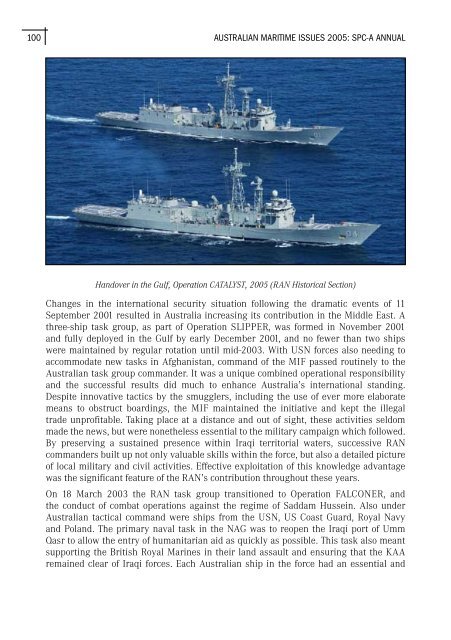Australian Maritime Issues 2005 - Royal Australian Navy
Australian Maritime Issues 2005 - Royal Australian Navy
Australian Maritime Issues 2005 - Royal Australian Navy
Create successful ePaper yourself
Turn your PDF publications into a flip-book with our unique Google optimized e-Paper software.
100<br />
AUSTRALIAN MARITIME ISSUES <strong>2005</strong>: SPC-A ANNUAL<br />
Handover in the Gulf, Operation CATALYST, <strong>2005</strong> (RAN Historical Section)<br />
Changes in the international security situation following the dramatic events of 11<br />
September 2001 resulted in Australia increasing its contribution in the Middle East. A<br />
three-ship task group, as part of Operation SLIPPER, was formed in November 2001<br />
and fully deployed in the Gulf by early December 2001, and no fewer than two ships<br />
were maintained by regular rotation until mid-2003. With USN forces also needing to<br />
accommodate new tasks in Afghanistan, command of the MIF passed routinely to the<br />
<strong>Australian</strong> task group commander. It was a unique combined operational responsibility<br />
and the successful results did much to enhance Australia’s international standing.<br />
Despite innovative tactics by the smugglers, including the use of ever more elaborate<br />
means to obstruct boardings, the MIF maintained the initiative and kept the illegal<br />
trade unprofitable. Taking place at a distance and out of sight, these activities seldom<br />
made the news, but were nonetheless essential to the military campaign which followed.<br />
By preserving a sustained presence within Iraqi territorial waters, successive RAN<br />
commanders built up not only valuable skills within the force, but also a detailed picture<br />
of local military and civil activities. Effective exploitation of this knowledge advantage<br />
was the significant feature of the RAN’s contribution throughout these years.<br />
On 18 March 2003 the RAN task group transitioned to Operation FALCONER, and<br />
the conduct of combat operations against the regime of Saddam Hussein. Also under<br />
<strong>Australian</strong> tactical command were ships from the USN, US Coast Guard, <strong>Royal</strong> <strong>Navy</strong><br />
and Poland. The primary naval task in the NAG was to reopen the Iraqi port of Umm<br />
Qasr to allow the entry of humanitarian aid as quickly as possible. This task also meant<br />
supporting the British <strong>Royal</strong> Marines in their land assault and ensuring that the KAA<br />
remained clear of Iraqi forces. Each <strong>Australian</strong> ship in the force had an essential and

















